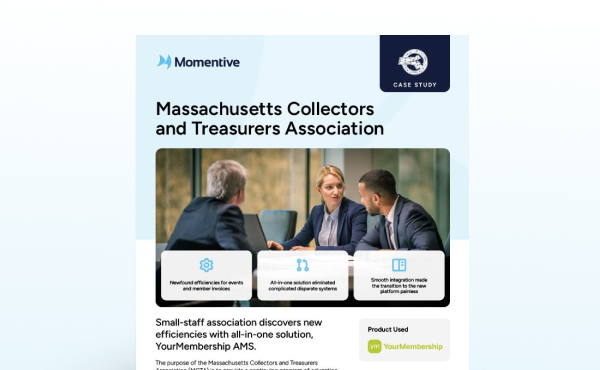While you hoped that you would never have to experience a crisis impacting your association, here you are. Every day brings more uncertainty with the spread of Coronavirus and your association has a need to expand your communication. Here are four communication tips to assist small-staff associations in displaying responsiveness, partnership and kindness.
- Keep members up to date with valuable information
Response to the COVID-19 pandemic is changing every day. Keep your members up to date on your association’s response including your office work procedures, events calendar and any other necessary news. Remember, that most businesses are sending out communication during this time so make sure that you are sending the relevant information at the right time. Different people will hear messages differently so utilize multiple communication channels to communicate with your members.
With many businesses implementing work from home policies to help flatten the curve with this virus, re-enforce your association’s value in this new work from home environment. Pull together some of your best content and create a “X Industry Work from Home Survival Kit” or “X Industry Bucket List” for members continuing education. Your kit should include links to your latest and “oldie but goodie” blogs, latest industry news, and access to previous webinar recordings. Advocacy actions that can be done in minutes from home also great to include in your kit. You can also include a “Continuing Education Checklist” that members can easily complete while working from home.
2. Pay close attention to the communications you receive
During times of crisis, threat actors seize the opportunity to use people’s fear and interest in COVID-19 to take advantage of the situation. They try to get people to share information, click links, open attachments, and visit false COVID-19 information websites and malicious online artifacts in order to gain access to systems, information and sensitive data.
Things to look for to help protect you, your organization and your members include:
- Attachments that look like a CoronaVirusSafetyMeasures_pdf, Coronavirus countermeasures, COVID-19 emergency status official government or state announcements or documents
- Messages that appear to be official announcements with links to websites for more information
- Phone calls claiming to be a CDC, WHO, state, or government representative or an emergency responder
- They may request personal information about you or family members.
- They may ask questions about your health status or other related information.
- They may use information previously collected to try to trick you into believing a loved one is gravely ill and needs your immediate financial help.
- They may claim some kind of emergency action you must take to avoid criminal actions for not complying with regulation actions being taken.
A few reminders to help ensure you don’t fall prey to a threat actor:
- Avoid clicking on links in unsolicited emails and be wary of email attachments, even from people you know.
- If an email or email attachment seems suspicious, don’t open it. Contact the person who supposedly sent the message to make sure it’s legitimate before you open the attachment.
- Use trusted sources, such as legitimate government websites, for up-to-date, fact-based information about COVID-19. Open a browser and go to the site directly, don’t use links in emails to take you to the website.
- Do not reveal personal or financial information in emails.
3. Embrace barks and wails
Some people are accustomed to working from home and have well-established home office configurations. With school closures and mandatory work from home, there are many people working from home that aren’t accustomed to it. Some may struggle to find appropriate workspace or may have to share space with a spouse and/or babysitter. Be patient with others and with yourself. Dogs barking, kids crying or hearing a spouse on another call most likely will occur during these times. No need to stress about it, just embrace the barks and wails.
4. Don’t forget a daily dose of gratitude
During these times, one of the kindest things we can do is say, “thank you”. Consider adding in a daily dose of gratitude to your schedule. Use this opportunity to thank your members and volunteers through a handwritten note, personal email or even a phone call. If you would like to give a more public recognition, post a shout-out on your online community. Just remember, if you are thanking a group publicly, don’t forget to leave anyone out.
A great way to remember your daily dose of gratitude is to set a recurring appointment on your calendar every day at the same time. If you’re ready to take your gratitude to the next level, set an alarm for every hour during work hours.
Don’t confine your gratitude to work hours. You can also use this opportunity to thank those that have continued to work during business closures such as grocery store employees, your Amazon delivery person or food delivery person. Don’t forget to thank those in the medical field such as first responders, nurses and doctors.
In times of crisis, communication is a necessity. Show your association’s leadership by providing communication that’s responsive and kind to your members, supporters and staff.
*This article is not intended to be a substitute for professional medical advice. The writer is not an expert in epidemiology or a healthcare professional.
The World Health Organization (WHO) and the Centers for Disease Control (CDC) are monitoring the situation in real-time, and while much is still unknown about how the virus spreads, both organizations have issued guidance for preventing exposure to respiratory illnesses, as well as planning considerations for places of business.
It is our position that these organizations are the best resources for up-to-date, science-based information about the Coronavirus disease. We share links to some of this information below.
Coronavirus Disease (COVID-19) Resources:
World Health Organization : https://www.who.int/emergencies/diseases/novel-coronavirus-2019 – Find rolling updates on the virus, workplace readiness, basic protective measures, and press briefings.
Centers for Disease Control and Prevention: https://www.cdc.gov/coronavirus/2019-ncov/index.html – Find information for businesses, interim guidance, and frequently asked questions about the virus.






